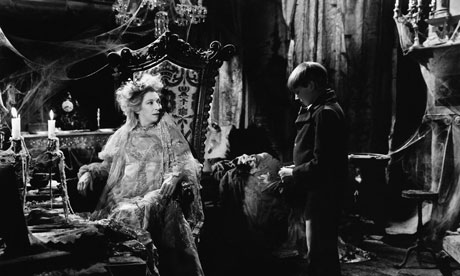From Miss Havisham's decaying domicile to Jekyll and Hyde's shared space, fictional homes are as varied as their inhabitants

Stopped clocks and cobwebs … Miss Havisham (Martita Hunt) at home in David Lean's Great Expectations. Photograph: Allstar/Cinetext
Ideas of home are nebulous, ranging from "where the heart is", to the slightly less warming sentiment of Robert Frost: "The place where, when you have to go there, they have to take you in." Over the course of writing If This Is Home, I spent a lot of time thinking about how people attribute places, people and areas to "home". But for the purposes of this very personal top 10 I had to cut it down somehow. I decided to restrict it to traditional homes in novels – ie buildings in which fictional characters live. With regret, therefore, I've had to leave out William Faulkner's Yoknapatawpha County, Richard Ford's Haddam, Patrick Hamilton's The Midnight Bell, Joan Didion's house in The Year of Magical Thinking, every home that Alice Munro has ever described, not to mention the prisons, bars and hospitals that are as much homes as they are establishments.
Read the full list at The Guardian
1. Satis House, in Great Expectations by Charles Dickens
Miss Havisham's decaying lair is as much of as an intrigue as the character herself. Stopped clocks, rooms paused in time, a name that literally translates as "enough": Satis House is home, prison and memorial – a wonderfully realised expression of the contradictions of being at home.2. Des Esseintes' country house, in A Rebours by Joris-Karl Huysmans
Possibly the most intricately detailed and described home in literature, the place where the Duc Jean des Esseintes heads to spend his life in decadent contemplation is a home of extraordinary richness, of obsessive attention to detail. It is a place where he can live out his aesthetic fancies and fantasies. It is, however, a house in which you feel that only des Esseintes could feel at home.3. Bartlebooth's apartment, 11 Rue Simon-Crubellier in Life a User's Manual by Georges Perec
Perec's masterpiece – and to my mind the greatest novel since Ulysses – takes place in a Parisian apartment block just after the death of eccentric Englishman Bartlebooth on 23 June 1975. Perec ghosts around the rooms, telling the stories of the inhabitants, showing the lives that have populated the place over the preceding years. It is Bartlebooth's that is the most interesting: a simple place of retreat; a home as a place of reflection on the rest of the world.4. Thrushcross Grange in Wuthering Heights by Emily Brontë
The scene in which Cathy and Heathcliff first come across their well-to-do-neighbours' house has remained, for me, one of its most enduring images. The Heights is a working farm, a place of labour; the Grange is about leisure, luxury, relaxation. In such a colourless and blasted narrative, the deep crimsons and golds of the Grange's decorations show class divisions in an unsubtle yet highly effective manner. Heathcliff's return and ownership – yet lack of residence – of the place also serves to show home, unlike wealth or status, as a place even more difficult to escape.Read the full list at The Guardian

No comments:
Post a Comment